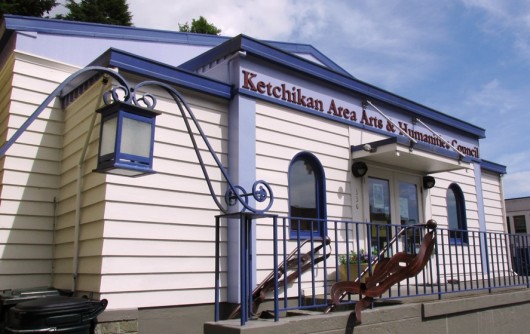 The Ketchikan Area Arts and Humanities Council is one of 10 Alaska art organizations chosen for a three-year program aimed at teaching the groups how to keep up with changes in their communities, in order to remain relevant into the future.
The Ketchikan Area Arts and Humanities Council is one of 10 Alaska art organizations chosen for a three-year program aimed at teaching the groups how to keep up with changes in their communities, in order to remain relevant into the future.
The New Pathways Alaska news release announcing participants of this new venture describes it as an “adaptive change” program that helps arts organizations “accelerate the adoption of ‘next practices’ in the field.”
What?
Here is Ketchikan’s Arts Council’s Executive Director, Kathleen Light, explaining what adaptive change means:
“Being adaptive to what your economy is doing, you’re your community is doing, what’s happening socially or politically within your community, how are you adaptive and able to ride the wave,” she said. “I like to think of it as evolving with your community.”
And if all goes well, they’ll learn how over three years. That’s how long the program lasts, and it will involve at least a couple Arts Council employees plus some board members.
New Pathways Alaska is a new project, organized jointly by the Rasmuson Foundation, Foraker Group and Alaska State Council on the Arts, along with the New York-based EmcArts.
The program is free to the chosen organizations. Light said there will be some meetings they have to travel to attend – paid for by the program.
“And then we have virtual meetings, which our whole entire board can participate in,” she said. “And then we’ll have visits from EmcArts and probably Foraker. And everybody can participate in that.
“Those are the things where everybody gets to learn a little bit and that where I think the value comes in, because we can all spread our knowledge throughout the community with the other organizations, with everybody. We can just disseminate what we’re getting and put it out there.
“I’m thrilled. I’m so excited that we were selected.”
Light said everyone had one month’s notice to apply for the program, which means the organizations chosen already had to be moving in the right direction. She said Ketchikan’s arts council has been adapting to community needs. That’s why the nonprofit recently added an education coordinator position to the staff.
Light hopes that the New Pathways program will enhance what’s in place. And she can already envision it: “If the Arts Council is successful in touching every community member with art, or allowing art to be accessible to every community member, what does Ketchikan look like in 20 years? Isn’t that cool?”
She quickly added that art already is available to everyone in Ketchikan, but they’re not always aware of that fact.
In addition to teaching how to create innovative, adaptive, relevant programming, New Pathways Alaska provides grant funding to help pay for it.
“In year 2, there’s a little bit of funding to take some baby steps with innovative incubation, so developing our innovative programming,” she said.
Then in year three, there’s a chance to receive a $75,000 grant to further develop those innovative programs.
The end result, it’s hoped, are arts organizations so in tune with the communities they serve, that their sustainability is not even a question.
“Sustainability is part of being relevant, right? If you are not sustainable, you’re certainly not relevant. The two go hand in hand,” she said. “If you aren’t sustainable, your programming probably isn’t relevant; and if you aren’t relevant, then you aren’t evolving with your community.”
And, Light said she’s happy to share the information with other nonprofit organizations in Ketchikan, to help them evolve and remain relevant, as well.
Other groups picked as the first participants of the new venture are the Alaska Humanities Forum, Alaska Native Heritage Center, Alutiiq Museum, Anchorage Concert Association, Anchorage Symphony Orchestra, the Sitka-based Island Institute, Kodiak Arts Council, Juneau’s Perseverance Theatre and the Haines-based Sheldon Museum and Cultural Center.





